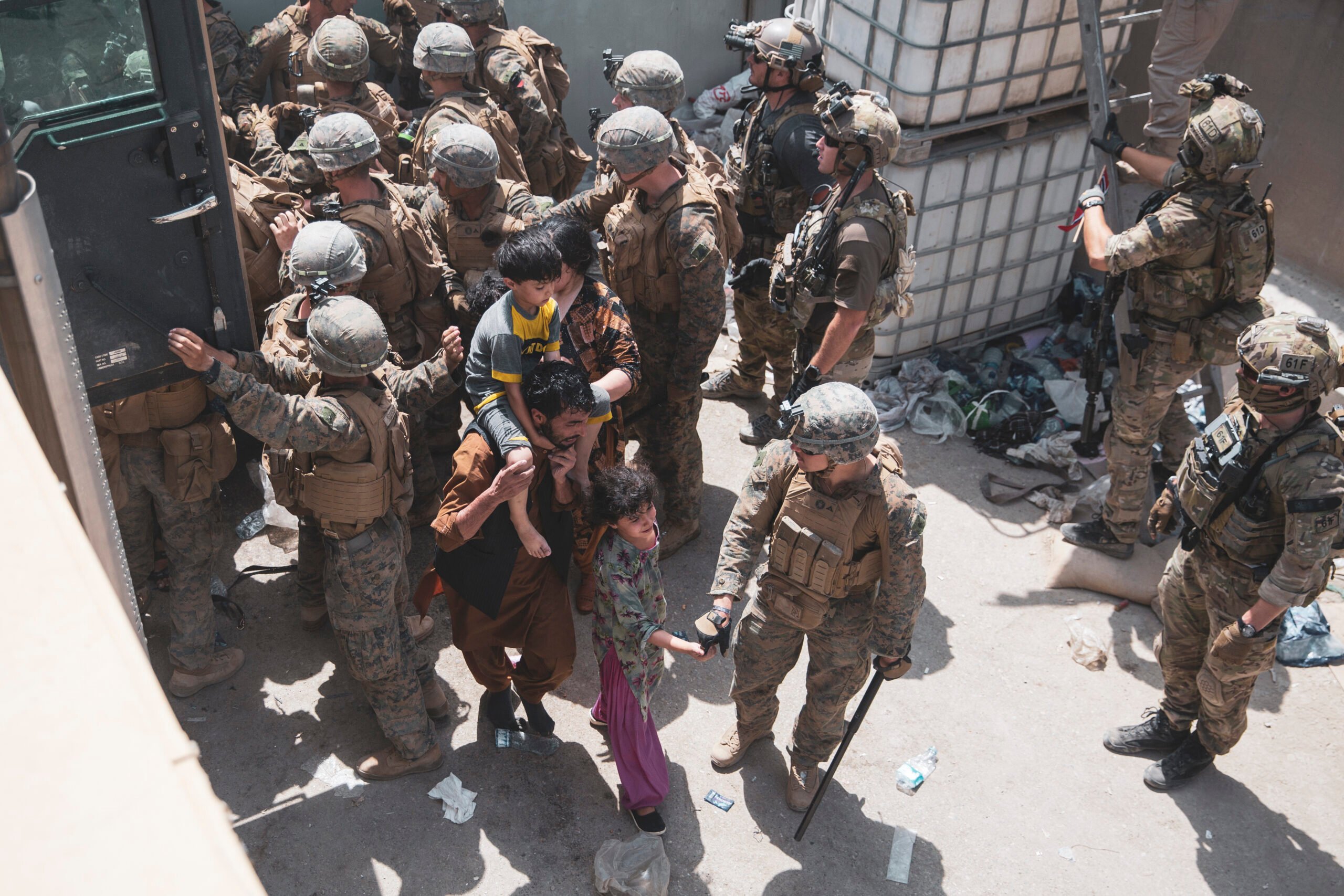
U.S. Marines and Norweigian coalition forces assist with security at an Evacuation Control Checkpoint ensuring evacuees are processed safely during an evacuation at Hamid Karzai International Airport, Kabul, Afghanistan, Aug. 20. (Marines/Victor Mancilla)
WASHINGTON: A dozen American servicemembers were killed by a coordinated terrorist attack on Kabul’s airport, but a top US officer said the Afghan evacuation mission will continue — even as he is prepared for further attacks in the coming days.
Gen. Kenneth McKenzie, the head of US Central Command, confirmed the deaths and added that 15 other servicemembers were injured in the attacks. McKenzie said he did not have a total for civilian casualties, but local reports have put the death toll around 60, with more than 100 injured.
The attack, which took place around 5 PM local time, involved a suicide bomber who got up to the gates of Hamid Karzai International Airport, commonly known as HKIA. The general was clear that the US would not hesitate to strike back as information is gathered.
“We’ve been clear all along that we’re going to retain the right to operate against ISIS in Afghanistan, and we are working very hard right now to determine attribution, to determine who is associated with this cowardly attack, and we’re prepared to take action against them,” McKenzie said. “24/7, we are looking for them.”
Twelve KIA makes this the deadliest attack on US troops in Afghanistan since the shootdown of Extortion 17 in 2011—and excluding helicopter shootdowns, the deadliest of the war, surpassing the 9 KIA at the 2008 battle of Wanat and 9 KIA in 2011 Kabul airport green-on-blue attack. https://t.co/redsV41CeA
— Wesley Morgan (@wesleysmorgan) August 26, 2021
McKenzie placed blame for the attacks on the ISIS terrorist group, saying the threat of another attack is “extremely real,” adding “We believe it is this desire to continue those attacks and we expect those attacks to continue, and we’re doing everything we can to prepare for those attacks.”
At several points during the half hour press conference, McKenzie highlighted concerns that ISIS is seeking to get a vehicle-based suicide bomb onto the airport where almost 6,000 American servicemembers are managing the evacuation effort. He also mentioned a desire to “lob” rockets into the airport, but stated his belief that anti-rocket systems in place will be able to neutralize that threat.
In an attempt to limit overall risk, the US has asked the Taliban to extend its security perimeter and close down a number of streets headed to the airport. Unsaid by the general: doing so will likely make it harder for anyone — especially Afghan nationals who supported the US over the last two decades and now fear for their lives — to make it to HKIA and onto an evacuation flight.
American leaders have reached “out to the Taliban who are actually providing the outer security cordon around the airfield, to make sure they know what we expect them to do to protect us and we will continue to coordinate with them as they go forward,” he noted.
That the US is reliant on the Taliban for its security may seem bizarre, but it is the reality of the situation in Afghanistan since the collapse of the previous government and the US withdrawal to within HKIA. And the general said he doesn’t believe the Taliban helped plot the attack, given both tensions between the Taliban and ISIS and the fact the Taliban have a vested interest in seeing the Americans leave the country.
“I don’t think there’s anything to convince me” that Taliban let it happen, he said. “They have a practical reason for wanting us to get out of here by the 31st of August…we share a common purpose. As long as we’ve kept that common purpose aligned, they’ve been useful to work with.”
Under guidance from President Joe Biden, the withdrawal of American forces is supposed to occur by Aug. 31. While groups have called upon Biden to extend that, there are no signs that deadline will change. Whether today’s attacks will have an impact on that debate is unknown, but reports on the ground said that US forces were starting controlled detonations of equipment at HKIA — which would mark the effort to leave the airport behind is now beginning.
McKenzie said buses have transferred civilians to the tarmac at HKIA in the hours since the attack, and stressed that there is no way to do the mission safely, as screening evacuees requires Marines to have direct contact with potential threats.
“It’s a noble mission, and today we have seen firsthand how dangerous this mission is,” he said.
Anduril’s Aussie drone sub ‘one year early and on budget,’ heads to production
Defense Industry Minister Pat Conroy said Anduril’s Ghost Shark is part of the Australian military’s $5.2 billion to $7.2 billion investment in undersea uncrewed maritime systems.


























